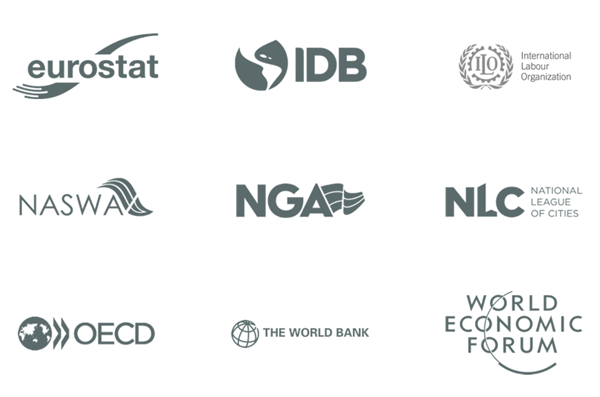
- Home
- Media Center
-
Events
- Wuzhen Summit
- Regional Forums
- Practice Cases of Jointly Building a Community with a Shared Future in Cyberspace
- World Internet Conference Awards for Pioneering Science and Technology
- The Light of Internet Expo
- Straight to Wuzhen Competition
- Global Youth Leadership Program
- WIC Distinguished Contribution Award
- Membership
- Research & Cooperation
- Digital Academy
-
Reports
- Collection of cases on Jointly Building a Community with a Shared Future in Cyberspace
- Collection of Shortlisted Achievements of World Internet Conference Awards for Pioneering Science and Technology
- Reports on Artificial Intelligence
- Reports on Cross—Border E—Commerce
- Reports on Data
- Outcomes of Think Tank Cooperation Program
- Series on Sovereignty in Cyberspace Theory and Practice
- Other Achievements
- About WIC
- 中文 | EN

LinkedIn Economic Graph
LinkedIn's Economic Graph is a digital representation of the global economy. Through Economic Graph insights, we create economic opportunity for every member of the global workforce.
Introduction:
As the world's leading professional network, LinkedIn was founded in 2003 and is headquartered in Silicon Valley, California, USA. LinkedIn's vision is to create economic opportunity for every member of the global workforce, and create the world's first Economic Graph. As of August, 2021, LinkedIn has more than 774 million members from more than 200 countries and territories around the world, with the number of Chinese members currently amounting to over 54 million.
LinkedIn's Economic Graph is a digital representation of the global economy. The data is from 774 million members, 38 thousand skills, 57 million companies, and 120 thousand schools. In short, it's all the data on LinkedIn.
Core value: Analyze big data and provide economic insights
Through mapping LinkedIn data, we are able to make predictions on the global economic activities, spot trends like talent migration, hiring rates, and in-demand skills by region. These insights can help connect talents and opportunities in new ways.
For example, LinkedIn's Economic Graph launched University Alumni Insights in 2020. We conducted a "portrait analysis" on the profiles of more than 218,000 graduates from 10 universities under the "Double First Class University Plan" (referred to as U10) in China. The research found career development of U10 graduates demonstrates a benign talent circulation trend of "studying abroad - returning China for work". Meanwhile, university graduates have become more flexible and diversified in employment and entrepreneurship since the COVID-19. These findings can also help graduates better face the professional challenges of the post-epidemic era.

Figure 1 The distribution of countries and regions U10 graduates first-time employment
The Economic Graph is not only a digital relationship map, but also an ideal policy reference tool. Through LinkedIn's big data insights, we are able to measure and understand complex dynamics of the global economy. We work with governments and NGOs around the world to leverage these insights to enhance global access to jobs and education.
Social impact: Responding to labor market challenges and contributing to the healthy development of the world economy
For a long time, LinkedIn's Economic Graph has paid close attention to topics such as digital talent, workforce confidence, gender equality, and green and sustainable development.
I. Development status of global digital talents. Since 2017, the LinkedIn's Economic Graph Team and Tsinghua SEM Center for Internet Development and the Governance (CIDG) have collaborated. Our study presents the development status of global digital talents and the development trend of the digital economy from an in-depth analysis of industry distribution, skill characteristics and migration of talents, to assist diverse countries and cities worldwide to better understand their own strengths and weaknesses of talent, the global talent trends, and to bring reference and inspiration to how to develop the digital economy in the future.

Figure 2 Top 5 representative skills in the Asia-Pacific cities (regions)
II. Workforce confidence in the talent market. Since the COVID-19, LinkedIn's Economic Graph can find out how workers feel about job stability, financial status, and career development by observing the trend of hiring rate, to help policy makers understand and support the difficulties faced by workers.
III. Sustainable development of the global economy. The LinkedIn's Economic Graph team identified about 800 core green skills and more than 300 green-related skills, covering 12 categories, including pollution prevention, waste prevention, renewable energy and sustainability. By identifying and tracking green skills, LinkedIn's Economic Graph unlocks more potential for the development of the global green economy.
IV. Gender inequality in the workplace and female career development. In 2021, the LinkedIn's Economic Graph and the World Economic Forum have cooperated to launch the Global Gender Gap Report, which points out the need to maintain a more flexible and friendly working environment for women, encourage women to engage in emerging jobs, and improve their disruptive skills.

Figure 3 Global partners of the LinkedIn's Economic Graph
LinkedIn China Economic Graph Researches List
Launch Date Research Name
Nov 2017 China Digital Economy Talent Report
Oct 2018 Digital Economy and Talent Development in Yangtze River Delta Region
Feb 2019 Digital Economy and Talent Development in the Greater Bay Area
Oct 2019 Digital Transformation of Chinese Industries
Nov 2019 Innovative Cities and City Clusters
Oct 2020 Global Digital Talent Index
Oct 2020 University Alumni Insights: Chinese Graduate Career Development Prospects 2020

Figure 4 LinkedIn China Economic Graph Researches

The World Internet Conference (WIC) was established as an international organization on July 12, 2022, headquartered in Beijing, China. It was jointly initiated by Global System for Mobile Communication Association (GSMA), National Computer Network Emergency Response Technical Team/Coordination Center of China (CNCERT), China Internet Network Information Center (CNNIC), Alibaba Group, Tencent, and Zhijiang Lab.





